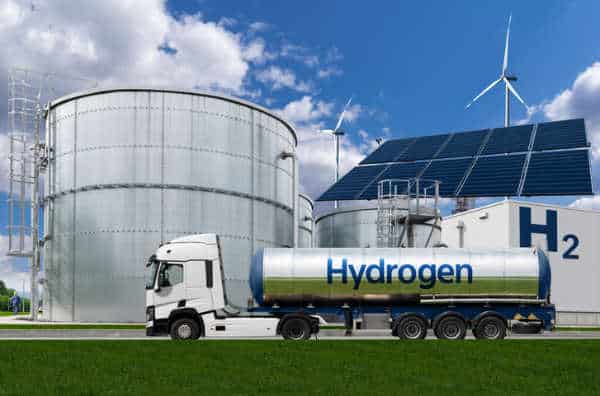The Biden administration has selected clean-energy projects from Pennsylvania to California for a $7 billion program to kickstart the development and production of hydrogen fuel, a key component of President Joe Biden’s agenda to slow climate change.
It’s probably another Solyndra scam in the making.
Biden called clean hydrogen essential to his vision of net-zero greenhouse gas emissions in the U.S. by 2050. His goal is to establish seven regional hubs to help replace fossil fuels such as coal and oil with cleaner-burning hydrogen as an energy source for vehicles, manufacturing, and generating electricity.
Biden’s vision, oh great.
The seven hubs, which include projects in 16 states, will spur more than $40 billion in private investment and create tens of thousands of good-paying jobs, many of them union positions, Biden said Friday at a cargo terminal in Philadelphia, where one of the hubs will be based.
When did we hear they will create tens of thousands of good-paying jobs that never materialize?
Biden Said It’s Transformational
He called the announcement transformational and said it would help create “a stronger, energy-secure economy” and combat “the existential threat of climate change.”
“It’s all part of my plan to make things in America,” he said.
The projects selected are based in California, Washington, Minnesota, Texas, Pennsylvania, West Virginia, and Illinois. All but the California and Texas hubs include projects in multiple states. Pennsylvania has projects in two separate hubs.
Well, if Biden says it.

Critics say Hydrogen cars are a bad idea because:
- It’s not green
- The process is inefficient
- Hydrogen vehicles are too expensive
- The status quo is maintained
- Battery technology is improving
Research conducted by Princeton University and the National Oceanic and Atmospheric Association suggests that widespread use of hydrogen power could result in long-term environmental complications.
From SciTechDaily:
The reason for this is that hydrogen gas reacts readily in the atmosphere with the same molecule responsible for breaking down methane, which is a potent greenhouse gas. If the level of hydrogen emissions surpasses a specific threshold, this shared reaction is likely to result in an accumulation of methane in the atmosphere, leading to long-term climate consequences.
“Hydrogen is theoretically the fuel of the future,” said Matteo Bertagni, a postdoctoral researcher at the High Meadows Environmental Institute working on the Carbon Mitigation Initiative. “In practice, though, it poses many environmental and technological concerns that still need to be addressed.”
Lots of Methane
Bertagni is the first author of a research article published in Nature Communications, in which researchers modeled the effect of hydrogen emissions on atmospheric methane. They found that above a certain threshold, even when replacing fossil fuel usage, a leaky hydrogen economy could cause near-term environmental harm by increasing the amount of methane in the atmosphere. The risk for harm is compounded for hydrogen production methods using methane as an input, highlighting the critical need to manage and minimize emissions from hydrogen production.
Tesla CEO Elon Musk calls hydrogen “the most dumb thing I could possibly imagine for energy storage.”
CNBC:
During an interview at the Financial Times Future of the Car summit on Tuesday, Musk was asked if he thought hydrogen had a role to play in accelerating the transition away from fossil fuels.
“No,” he replied. “I really can’t emphasize this enough — the number of times I’ve been asked about hydrogen, it might be … it’s well over 100 times, maybe 200 times,” he said. “It’s important to understand that if you want a means of energy storage, hydrogen is a bad choice.”
In June 2020, he tweeted, “fuel cells = fool sells.” He added in July of that year: “Hydrogen fool sells make no sense.”
“It does not naturally occur on Earth. So you either have to split water with electrolysis or crack hydrocarbons,” he told the Financial Times.
“When you’re cracking hydrocarbons, you really haven’t solved the fossil fuel problem, and the efficiency of electrolysis is poor.”
Hydrogen projects use electrolysis.
“The efficiency of electrolysis is … poor,” he told the Financial Times. “So you really are spending a lot of energy to … split hydrogen and oxygen. Then you have to separate the hydrogen and oxygen and pressurize it — this also takes a lot of energy.”
“And if you have to liquefy … hydrogen, oh my God,” he continued. “The amount of energy required to … make hydrogen and turn it into liquid form is staggering. It is the most dumb thing that I could possibly imagine for energy storage.”
One equity manager told CNBC we need something more than renewables to get to net zero. He guesses that once we have the solution, it will take over 15% of the market.
He clearly stands to gain money, and he doesn’t know if this will work at all. Thus, they need the bottomless taxpayer pit to subsidize it.
The Left is desperately looking for something to replace gas, but they have nothing, and they’re experimenting with tax dollars while we are $33.5 trillion in debt. They are passing stringent mandates without a plan, just experiments. It’s another waste of tax dollars instead of letting the market decide.
Subscribe to the Daily Newsletter